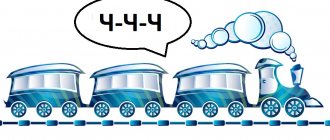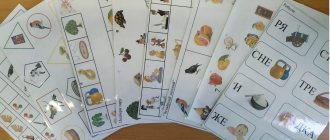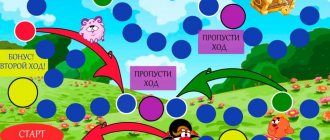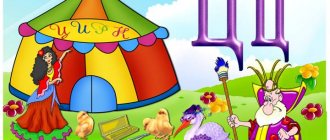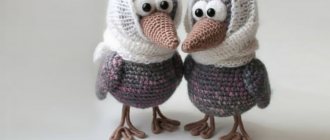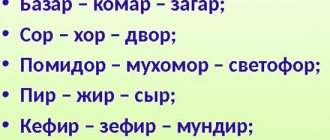Summary of individual speech therapy lesson “Producing sound [L]”
The little steamboat decided to learn how to whistle correctly. He began to try different greeting options: “Uh!” ABOUT! No, that’s not it!” Out of frustration, the little steamboat bit his tongue and said: “Y.”
And then a miracle happened: a clear and distinct sound [L] sounded. The little steamboat thought that he had misheard, and repeated: “Y”, biting his tongue again. The sound [L] became even more distinct.
Hearing the voice of the small steamboat, the large ships began to answer him with loud and drawn-out whistles: “L!”, “L!” So the little steamer learned to whistle correctly.
The child bites the tip of the tongue and pronounces the sound [Y] in a drawn-out manner. At the same time, the sound [L] should sound. After the sound [L] is obtained in isolation, attach it to the vowels: LA, LO, LU, LY, LE. At first, you will still have to bite the tip of your tongue. If it is difficult to do this in a forward syllable, try reverse syllables: AL, UL, OL, IL, EL, YL.
Then you need to try to remove your tongue behind your teeth!
The child repeats the syllables LA-LA-LA and for each syllable he “moves” his teeth off his tongue until it touches the inner surface of the incisors.
3) From the exercise “The mouse is hiding”
The child bites the tip of his tongue and pronounces the sound “Y” in a drawn-out manner. The tip of the tongue is the tail of a mouse, and the mouth is a mink. The speech therapist takes a toothpick and tells the child to quickly move the tip of his tongue behind his upper teeth, otherwise he will prick the “tail of the mouse” (in fact, the speech therapist only lightly touches the tip of the tongue). First, this can be demonstrated on a chattering toy, and then the speech therapist performs this exercise with the child.
4) From the
“Strong Tongue”
, the speech therapist asks the child to press the strip with his tongue as he shows on himself (lips in a smile, mouth open, place the strip in the middle on the tip of the tongue and press it to the upper palate). Then, we ask the child to tug on the strip that the speech therapist pinched - “take it away from me!”
. “And now, you also press your strip with your tongue so that it is difficult for me to take it away from you”:
-Show me how you pressed the strip with your tongue. Now sing the song: “A-a-a-a-a-a!” and press your tongue behind your upper teeth as you learned now (You need to cover a piece of paper with tape and cut it into strips. The width is at least 1 cm. The length is optional).
3. Development of phonemic processes
.
●"Catch the Sound"
Listen again to the sound of the steamer. Sound your horn yourself. (take a picture symbol of the sound L).
When you hear the sound L, then pick up the picture of the steamer, if you don’t hear it, then sit quietly.
Approximate sound series: M-N -L -A-U -O-L-V -3- V-M-L-X-N- M -N -L-A-U-O-L-V-3- V - M - L - X - N - B - W
● And now I have prepared the game. Here is a picture of a Spoon and a Lamp. If the picture is named correctly, clap your hands; if it is incorrect, don’t clap.
MAGAZINE Preschooler.RF
Completed by: Teacher-speech therapist Koshkina I.I. Objectives: • consolidate the correct pronunciation of the sound “L” in words; • development of phonemic processes (ability to determine the presence of sound in words, position of sound in words; skills of sound analysis and synthesis); • development of attention, memory, thinking, perception, speech and fine motor skills; • education of consciously correct pronunciation of the sound l.Equipment: • flat figurine of Cinderella; • object pictures whose names contain the sound l; • card with overlaid images; • elements of a ball gown for Cinderella; Progress of the lesson: 1. Organizational moment. Hello! Sit comfortably. Listen carefully to all my tasks and you will succeed. 2. Articulation gymnastics. First, let's set up the tongue to work: Performing exercises for the tongue: - “Snake” - The mouth is wide open. Push the narrow tongue forward and then remove it deep into the mouth. - “Swing” - Mouth open. With a tense tongue, stretch either to the nose or to the chin. - “Delicious jam” - The mouth is open. Using a wide tongue, lick the upper sponge (from top to bottom) and then remove it into the back of your mouth. - “Painter” - Mouth open. Using the wide tip of the tongue, like a brush, we move from the upper teeth to the soft palate and return back without lifting it off. - “Brushing our teeth” - Mouth open. We move the tongue in a circular motion between the lips and teeth. - “Hide the candy” - Mouth closed. The tense tongue rests first on one cheek, then on the other. Performing exercises for the cheek muscles: - “Inflate two balloons” - inflate your cheeks and hold air in them. Then move the air from one cheek to the other. - “Skinny Petya” - Retract your cheeks with your lips closed. 3. Report the topic of the lesson. Today we continue to learn how to correctly and clearly pronounce the sound “L” in words. 4. Clarification of correct articulation. Let us remember and show how the organs of articulation work when pronouncing the sound “L” correctly. What do the lips do when we pronounce the sound “L”? Where is the tongue? 5. Isolated sound pronunciation. Let's pretend the bell sings a song. We depict a bell with our hands: the backs of the hands are facing upward, the fingers of both hands are crossed, the middle finger of the right hand is lowered down and the child moves it freely in one direction or the other. We pronounce the poem: “The fat” bell sang a song and rang very loudly in a bass voice - la - la - la ... Biting the tongue, we simultaneously pronounce the sound “A”, receiving - la-la-la. Then we slow down the imitation of the ringing of the bell la-la-la and just start humming - lllll (without the vowel “a”). 6. Work on the topic. 1) Today a guest came to our lesson. Let's guess her name. A flat figurine of Cinderella is displayed.) - Remember what work Cinderella did?
- Complete the sentence by adding action words that are appropriate in meaning so that they contain the sound l. 1. Cinderella floors...(soaped, swept, polished), 2. linen...(washed, ironed), 3. oven...(heated), 4. lunch...(cooked, cooked), 5. dishes...(soaped, cleaned) . 2) Work on the development of phonemic processes (determining the position of sound in words). Remember where Cinderella wanted to go? Can we help Cinderella get to the ball? — Before going to the ball, Cinderella must put things in order in the pantry - arrange objects on shelves, taking into account the place of the sound l: she will put objects with the sound l at the beginning of the word on the bottom shelf, with the sound l in the middle of the word - on the middle shelf, with the sound l at the end of the word - on the top shelf. Subject pictures: skis, spoon, light bulb, magnifying glass, chalk, pencil case, glass, saw, needle, ball, bottle. 3) Name words with one syllable, two syllables, and three syllables. Chalk, Ski-zhi, spoon-ka, lu-pa, pen-nal, bo-kal, pi-la, club-bok. Lam-knock-ka, and-gol-ka, boo-bang-ka. 4) Repetition of pure language. Cinderella loved to sing the song. Let's learn it too. You just need to add words with the sound “L” to the rhyme. Al-al-al, Cinderella hurries to... (ball) Ol-ol-ol, deftly sweeps with a brush...(floor) Ul-ul-ul, she won’t even sit down on... (chair) Ol-ol-ol, the prince is fascinated by her... (was) Il - il - il, she was invited to dance... (invited) 5) Work on the development of fine motor skills. (Task using reusable stickers). How will Cinderella get to the ball without a ball gown? Make a beautiful dress for Cinderella. (The dress consists of separate split parts). (Cut Cinderella’s dress into several parts. The child assembles the dress from the cut parts.) 6) Work on the development of phonemic awareness (isolating words with the sound “L” from a poem). So Cinderella got to the ball with our help. There she will have fun and dance. Now let's go to the forest ball and see how the inhabitants of the forest spend their time. Now I will read a poem. Listen to it carefully and remember who it says. Forest ball. The squirrel was crying - at the ball she stained her paws in yellow chalk. The elk took pity on the cute squirrel: he stroked his paws and the chalk flew off. The squirrel put on a satin dress with a long hem and a white belt. Oh, how magically she danced - she flew from tree to tree like a feather. The spruce paws rocked the squirrel, the woodpeckers sang a merry song, and chiseled the tree trunks with their hollow beaks. It's a nice thing to fly around balls.
Who is this poem talking about? And now I will read several lines at a time, and you choose words with the sound “L”. 7) Summary of the lesson. What sound did we learn to pronounce correctly today?
| Next > |
